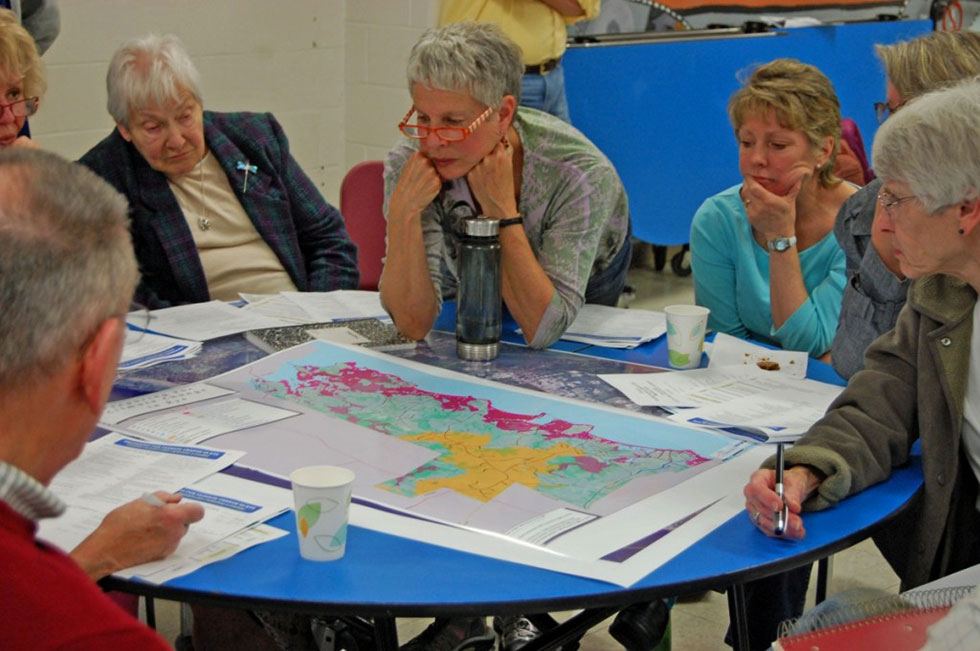Focus Areas
CAW focuses on meeting specific community needs, as identified and defined by the communities themselves. Recognizing that the communities within the region are small, often governed largely by volunteers, and facing many competing priorities, CAW has provided important capacity on a consistent and coordinated scale that has supported these small towns and cities to begin tackling the longer term need to prepare for climate change. Over the years, CAW members have assisted communities to understand relevant climate science, complete assessments, incorporate climate into plans and regulations, and conduct outreach campaigns, to enhance resilience to coastal hazards.
Community Outreach & engagement
CAW members have implemented a range of programs to engage municipal boards, staff, and residents in identifying priorities and developing strategies for climate adaptation. For example:
- Climate All-Boards Forums – CAW members have facilitated workshop events where municipal staff across departments and volunteer boards/committees come together to learn about available climate-related information and resources and discuss ways they can incorporate it in their work and decisions. This has been hosted in Exeter, Dover, Newmarket, New Castle, and Portsmouth, and in some cases has resulted in a landing page of resources for boards and staff to reference (see example from Exeter).
- As part of ongoing efforts to reach new audiences CAW members developed a program, Climate in the Classroom, focused on facilitating learning opportunities for students about climate change, including community events where students present what they have been learning to an audience of family members and municipal board members and staff. Learn more.
- Preparing for Climate Change workshop series – “This program really helped our community get more engaged in thinking about climate adaptation strategies,” said Kim Reed, Town of Rye Planning and Zoning Administrator. Art Reed, Police Chief and Deputy Emergency Manager in Newfields, credited the program with building the support he needed to get a discounted generator program started in town to help residents prepare for storm-related outages.
- Other initiatives have included High Water Mark signs in several communities, a youth art project in Dover, a creative communications project in Durham.

Oyster River Middle School students share their research about climate change with their parents and teachers.
vulnerability Assessments, studies, & mapping
Examples:
Municipal planning & regulatory updates
CAW members from the Rockingham Planning Commission, Strafford Regional Planning Commissions, and EF Design and Planning, for example, have assisted many coastal communities to understand their vulnerabilities and adaptation opportunities by developing maps, supporting planning efforts, and improving regulations to account for climate impacts. CAW members have supported communities to develop climate-related content in Hazard Mitigation Plans, Master Plans, checklists for land conservation planning, capital improvement planning, and more. CAW also convenes a bimonthly “CAW Talks” group of municipal staff and volunteer board members – these meetings provide opportunities for shared learning and professional development.
|
Read about some examples here:
|
Rye residents meet to discuss preliminary sea-level rise scenario maps and identify community vulnerabilities. |
On-the-ground projects
Living shorelines
CAW members have worked with partner organizations and communities to advance resilient shoreline management strategies that better protect communities and their resources from erosion and flooding associated with coastal storms and sea-level rise. New Hampshire’s tidal shoreline provides an important connection between our communities and the natural environment, valuable economic and recreational opportunities, and our history. Living shoreline projects have emerged as a resilient approach that can provide improved shoreline protection, better adapt to rising sea levels, require lower repair costs, and preserve higher quality habitat for fish and other species.
CAW has published stories, held workshops, and partnered on projects related to resilient shoreline management. Read more about this work:
- Great Bay Living Shoreline Project
- Wagon Hill Farm Living Shoreline Project
- NH Smart Shoreline Project: Living Shoreline Suitability Assessment

CAW member Kirsten photographs the eroding shoreline at Wagon Hill Farm on Durham Day. Photo by Todd Selig.
Resilient Culverts
Dune Restoration
NH Coastal Risk and Hazards Commission & the NH Coastal Flood Risk Summary
CAW members played an important role in the development of the NH Coastal Risk and Hazard Commission’s (CRHC) final report and supported implementation of the CRHC recommendations over the course of the next several years. Established in 2013, the CRHC was legislatively mandated to “recommend legislation, rules, and other actions to prepare for projected sea-level rise and other coastal and coastal watershed hazards…and the risks such hazards pose to municipalities and state assets in New Hampshire.” Comprised of 37 representatives from NH’s State Legislature, state agencies, 17 Atlantic Coast and Great Bay municipalities, regional planning commissions, academia, and the private sector, the bi-partisan Commission unanimously adopted its final report and recommendations in November 2016. The report Preparing New Hampshire for Projected Storm Surge, Sea-Level Rise, and Extreme Precipitation summarizes NH’s vulnerabilities to projected coastal flood hazards and put forth science-based guidance for the State and 17 coastal zone municipalities to minimize flood risk and enhance resilience. CAW members subsequently provided outreach and assistance to communities to support implementation of the CRHC recommendations (through the “Setting SAIL” project).
As part of this effort, the CRHC established a Science and Technical Advisory Panel to distill the latest scientific research related to climate change and coastal flood risk, and to advise the Commission on the data and projections that should be used in developing its guidance and recommendations. This resulted in the 2014 Science and Technical Advisory Panel (STAP) Report. Now, RSA 483-B:22 directs NHDES to supervise updates to the 2014 STAP Report at least every five years. Beginning in November 2018, NHDES convened a STAP steering committee comprised of representatives from state agencies, regional planning commissions, the University of New Hampshire, coastal municipalities, and CAW to oversee and contribute to the development of the 2019-2020 New Hampshire Coastal Flood Risk Summary.
The 2019-2020 New Hampshire Coastal Flood Risk Summary is comprised of two parts, including “Part I: Science” and “Part II: Guidance for Using Scientific Projections.” CAW members helped facilitate public input opportunities during the development of the Guidance, as well as outreach and training opportunities to support awareness and use of these resources. NHDES is looking ahead to the next 5-year update, which will take place in 2024-25.

